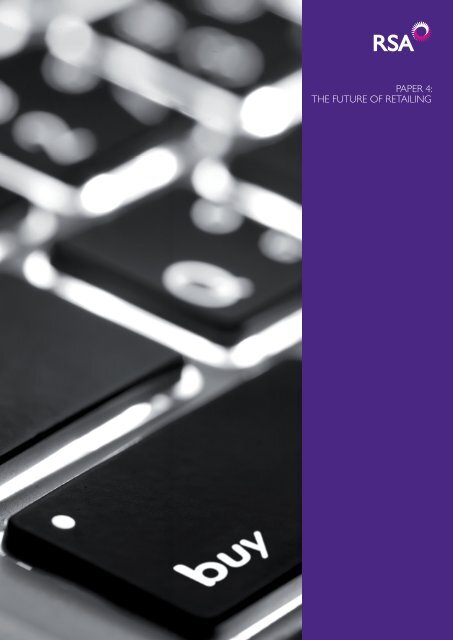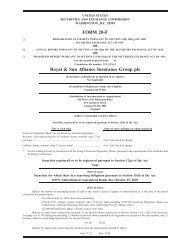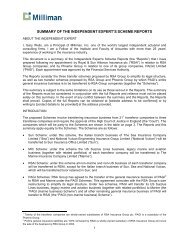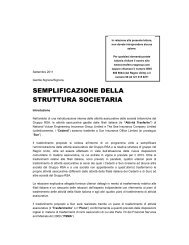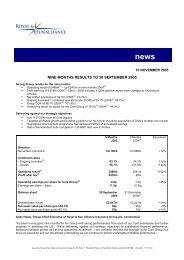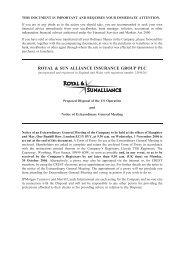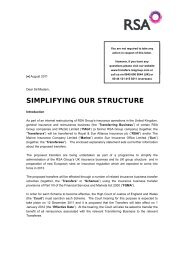Create successful ePaper yourself
Turn your PDF publications into a flip-book with our unique Google optimized e-Paper software.
PAPER 4:<br />
THE FUTURE OF <strong>RETAIL</strong>ING
<strong>RSA</strong>: THE <strong>RETAIL</strong> SERIES –<br />
THE FUTURE OF <strong>RETAIL</strong>ING<br />
Our fourth paper in <strong>RSA</strong>: The Retail Series is all about the trends<br />
leading us into the Future of Retailing. In truth, many of these<br />
trends are NOW, and this paper is out of date before it has been<br />
completed! There are many exciting, yet daunting, threads coming<br />
together to make up the retailing arena of the future. We have<br />
endeavoured to provide you with a fl avour of these in this, our<br />
penultimate paper.<br />
The Future of Retailing is being shaped by a number of<br />
trends, which we have highlighted in previous papers in our<br />
series, including:<br />
• Consumer demands and needs evolving due to population shifts,<br />
knowledge and changes in society<br />
• The impact of Retail Globalisation on the way that consumers<br />
buy in an increasingly homogeneous manner<br />
• Economic challenges driving more discerning and frugal<br />
customer behaviour<br />
• Environmental pressures and sustainability challenges for retailers<br />
generating new ways of building stores, managing logistics and<br />
creating or buying goods<br />
• And, of course, Technology.<br />
Technological advancements have meant that the way<br />
consumers buy has changed forever. As the main driver of<br />
future changes, we have focused on this area in particular in<br />
this paper. We have featured a number of exciting examples<br />
of truly innovative Retail implementations that are changing the<br />
face of shopping.<br />
At <strong>RSA</strong>, we are always researching and fi nding ways to understand<br />
our customers’ needs. We focus not just on today’s needs, but also<br />
aim to understand what the future holds for the organisations that<br />
we work with. This enables us to create the kind of partnerships<br />
that retailers of the future will demand. We look forward to<br />
hearing your views and working with you in the future,<br />
C<strong>HR</strong>IS SMITH<br />
Written with the support of Liz Machtynger of Customer Essential.
“The future is called ‘perhaps,’ which is the only possible thing<br />
to call the future. And the only important thing is not to allow<br />
that to scare you.”<br />
Tennessee Williams, Orpheus Descending, 1957<br />
DRIVERS OF CHANGE FOR THE FUTURE<br />
Predicting the ‘Perhaps’ of Retail is possibly a little more concrete<br />
than we might think. The ways in which innovative retailers are<br />
setting out their approach to stores and online retailing shows<br />
us the art of what is now possible. This opens the door to the<br />
potential trends of the future.<br />
There are four main threads coming together to drive the changes<br />
we are seeing in Retail. You will have read more about the fi rst<br />
three areas in our previous papers. This paper will take the fourth,<br />
the innovative use of technology and how this leads to the<br />
potential future Retail model, as the main focus.<br />
1. ECONOMIC PRESSURE<br />
The global recession, unemployment and subsequent challenges<br />
to consumer budgets have changed the emphasis of shopping<br />
for many. There is more focus on buying what is essential, at<br />
reasonable prices, and understanding the true value of items and<br />
how they compare with other items. ‘Knowledge’ and ‘comparison’<br />
have become essential to the customer and understanding these is<br />
fundamental to the way in which the retailer operates.<br />
Showing value, creating knowledge, providing product and<br />
service comparisons, and acting swiftly to convince customers<br />
are crucial in the future for retailers.<br />
2. ENVIRONMENT AND<br />
SUSTAINABILITY<br />
The impacts on and changes in the global environment are driving<br />
retailers to take more initiative and change the way they locate,<br />
build, source, partner, deliver and sell. The consumer is also waking<br />
up to sustainability and beginning to make purchase choices for<br />
durable, reusable, degradable, recyclable and charitable reasons.<br />
Global availability of key resources water and food will put<br />
pressure on and challenge retailers in the future.<br />
Innovating sustainable retailing experiences and products are<br />
key to the future for retailers.
3. ‘CONSUMER DRIVEN’<br />
CHANGE<br />
4. TECHNOLOGICALLY ENABLED<br />
INNOVATION<br />
People are living longer, moving around more, family units are<br />
varied, women are making more fi nancial decisions. Work<br />
is more segmented and carried out from remote as well as<br />
specifi c locations. Social connectivity is happening more between<br />
geographically distant friends and contacts. These are just a few<br />
of the changes in society that impact directly on the way that<br />
customers buy and what they need.<br />
Unemployment pressures, poverty, healthcare challenges, an<br />
increase in homelessness and pressure to fi nd homes, social<br />
welfare changes, legislation and taxation shifts are all changing<br />
some of the basic needs for consumers in the future.<br />
There is a whole world of technological advancement enabling<br />
creative connectivity, product development, process design and<br />
new experiences. Customers are increasingly making a shift to<br />
driving their own shopping decisions. They gain access to products<br />
and knowledge through whichever means they wish,<br />
and increasingly whilst on the move.<br />
Retailers at the forefront of key technological advancements in<br />
mobile, location-based, and in-store visualization and experience<br />
and content as well as mechanisms will steal a lead on their<br />
competition in the future.<br />
Getting closer to customers, communicating and understanding<br />
needs and changes in requirements are essential to the retailer<br />
in the future.
A SHOPPING EXPERIENCE...<br />
NOT SO FAR AWAY<br />
The seasons have changed fast in London, and Emily has realised<br />
she needs some lighter clothes for work. It is only two or three<br />
years ago (2012) that she would have waited until the busy<br />
workweek was over and headed off on a shopping expedition in<br />
search of the right outfi t.<br />
She remembers seeing something she liked in the magazine she<br />
was reading the day before. She picks it out and scans the code.<br />
Now all she needs to do is call up her personal shopper on video<br />
phone. The shopper will know all her usual preferences and start<br />
the search. She passes the scanned code on to her too. Within<br />
the hour she will have some image recommendations for her in<br />
3D shown on her own body shape.<br />
From these, Emily can link to customer reviews, and best prices.<br />
She can look up the closest place to try them on and book a<br />
slot in the next break in her schedule.<br />
When she goes to the store, the assistant already knows her;<br />
she has received her reservation information and a picture<br />
on her in-store mobile. She greets her warmly by name. The<br />
dressing room already has her items set out, and matching<br />
shoes and accessories.<br />
Whilst trying them on, she notices another customer with a<br />
handbag she likes, she takes a photograph of the bag to look up<br />
later. She scans the belt and fi nds the same one online with a<br />
better price. The sales assistant is very helpful and makes a<br />
better deal.<br />
She notices her friend has become available on the contact list<br />
on her mobile. Emily sends her a quick video clip of the outfi t for<br />
a fi nal bit of advice. Her friend likes it and sends a smiley face.<br />
Emily pays with her mobile there and then and decides to take<br />
the outfi t with her rather than asking the store to deliver. She<br />
receives a receipt on the mobile and a recycling code should<br />
she wish to pass the outfi t on to the store’s recycle department<br />
later on.<br />
On the way out of the store, a ‘thank you’ message with<br />
the image of the store assistant on it arrives. It also has a<br />
coupon for her next purchase, and there is a set of three<br />
photographs showing items she might like to spend the<br />
coupon on. She is also offered double coupons for feedback<br />
on her purchase experience and any items she might not<br />
have found at the retailer.<br />
Back at the offi ce, her friend loves the outfi t so much and asks<br />
her if she can scan the code with her mobile to buy the same in<br />
blue. Her friend orders it and has it delivered to a pick up point<br />
near to her home.<br />
When Emily wears her new outfi t to work, she notices it on a<br />
picture board at the train station as she walks by and smiles.<br />
All of the things set out in this picture are possible and available<br />
today. All of them are being trialled somewhere in the world.<br />
They haven’t quite all come together yet to make the complete<br />
experience for the customer.<br />
Read on to fi nd a number of developments that would make this<br />
experience work in the near future.<br />
CUSTOMERS FIND WHAT THEY<br />
NEED WHERE THEY WANT IT<br />
HOME DEPOT – SCAN QR CODES TO FIND OUT MORE<br />
A QR code is a two dimensional barcode that provides<br />
information to the reader on the whereabouts of further<br />
content relating to the code. These codes are now evolving<br />
to enable the retailer or company using them to incorporate<br />
their own logo or imaging ideas to be easily recognisable.<br />
Home Depot in the USA has been trialling the use of QR<br />
codes to allow customers to scan products or images and<br />
gain immediate information and video footage on hand-held<br />
devices. This has worked extremely well for them and they<br />
are now rolling out the approach. The link also provides<br />
customers with the comments of previous customers<br />
relating to the items scanned.<br />
“We know our customers are already using their mobile<br />
devices to assist in the purchasing process, and now Home<br />
Depot is embracing this technology to more closely connect<br />
our stores and customers to our digital content,” Tom Sweeney,<br />
Senior Director of Online Strategy for Homedepot.com, said<br />
in a statement.
IN-STORE BODY SCANNER –<br />
TELLS THE RIGHT SIZE<br />
AND CHOICE<br />
Scanners have been produced by companies such as MyBestFit<br />
or BodyMetric to measure the body of the customer in three<br />
dimensions. It then provides them with their body image and<br />
sizes. This can be used to select correct sizes or make bespoke<br />
items, suggest clothing selections or show images of the customer<br />
wearing specifi c items. The images can be stored for the customer<br />
to buy items more easily online without trying them on.<br />
KRAFT FOOD – SCANS<br />
CUSTOMERS IN-STORE<br />
TO WORK OUT THEIR MEAL<br />
Kraft in the US has installed scanners to scan customers when they<br />
approach; it identifi es their gender and age group to guess the kind<br />
of menu they might like. The screen advisor then provides recipes.<br />
If the customer is happy to swipe a store card or show their<br />
mobile, the scanner can provide more specifi c meal suggestions<br />
based on previous purchases or preferences.
INTERACTIVE SCREENS BROADEN<br />
THE RANGE AND OPENING<br />
HOURS – ADIDAS<br />
Interactive screen technology is enabling companies such as Adidas<br />
to create an experience in the store for the customer to select the<br />
item (shoe), modify the design of it and see it in three dimensions.<br />
They can get more information on the items they are looking at,<br />
change design aspects of products, and order them. They can look<br />
up history and recommendations on products too.<br />
This technology enables broader choice, a more interactive<br />
experience, but enables the retailer to improve supply<br />
management and merchandising. If sizes and stock are kept beside<br />
the screen in-store, the customer can still try things on and touch<br />
them before they buy.<br />
The Frauenhofer Institute in Germany is trialling a way to<br />
include similar technology in shop windows. This will enable the<br />
interactivity and purchasing to go on outside shop hours.<br />
“Gestural and gaming interfaces will become necessary in reaching<br />
a younger demographic. Interactive content can have as high as<br />
a 53% increase in attraction rate over static signage and 11%<br />
increase in average revenue per customer.”<br />
Jonathan Hull, Razorfi sh<br />
This technology has been advanced by virtual reality used in the<br />
online games industry, and is becoming able to recognise human<br />
movements, expressions and input. This gestural technology would<br />
enable interactive games and information to be exchanged with<br />
customers like Emily in the story above. The customer experience<br />
becomes more personalised and much more of an emotional<br />
connection can be made between the customer and the brand.
OFFERS MADE –<br />
HERE AND NOW<br />
STARBUCKS<br />
Retailers can now fi nd out the whereabouts of customers by<br />
using location based technology. If the customer allows them to<br />
use this information, they can make suggestions to customers<br />
on local offers specifi cally for them.<br />
Starbucks has been using the social media network Foursquare<br />
to identify where its regular customers are and rewards the<br />
‘mayors’ with a barrista badge and $1 discounts in store.<br />
WHERE TO FIND<br />
IT IN-STORE<br />
IKEA<br />
Continuing with the location theme, IKEA has provided its<br />
customers with an invaluable in-store service. Teaming up with<br />
google, it has provided the ability for customers to fi nd items in<br />
their stores by navigating using a google map.<br />
To view, visit,<br />
http://www.youtube.com/watch?v=T8niWVcLEgw<br />
WHAT’S IN STOCK?<br />
Some retailers are testing out the use of aisle411, which is an<br />
application enabling customers to fi nd specifi c items they need<br />
in-store. The application could also enable customers to build<br />
shopping lists from recipes, and fi nd out what is in stock in the<br />
stores nearby. Customers can check in at the store to receive<br />
offers using this app too.<br />
Applications like this can make it much easier for more local stores<br />
to attract business if they maintain good deals and information<br />
on their products.
CUSTOMER EXPERIENCE<br />
THE <strong>RETAIL</strong> STORE<br />
THE REAL STORE EXPERIENCE – APPLE<br />
The importance of a branded and recognisable store experience is<br />
growing and in the future will become more important, not just for<br />
fun, but also for utility.<br />
Despite many other competitors selling products more cheaply<br />
and online, Apple has created a remarkable store experience that<br />
customers are willing to travel for and pay for.<br />
Apple has a brand that is all about ‘cool, innovation, friendliness and<br />
quirky’. Human interaction and the delivery of outstanding service<br />
is key to the Apple brand. Apple’s staff are well trained and go out<br />
of their way to assist customers. The customer is encouraged to<br />
hang out and try products before buying them.<br />
CHANGING ROOMS<br />
When a customer wants to try something on, rather than just<br />
looking at a 3D image on a screen, they can go to a store and<br />
try the items. Some stores have outstanding changing rooms to<br />
enhance the in-store experience. Bloomingdales in Santa Monica is<br />
one example: it has special pods that come down from the ceiling<br />
to become changing rooms.<br />
Customers will want to return to the store to try things out and<br />
buy because there is always a real focus on service and assistance<br />
for the customer.<br />
“67% of customers who try on items buy them. Only 10% of<br />
customers make a purchase that they haven’t tried on. That’s<br />
why stores have begun to make changing rooms more attractive<br />
to customers.”<br />
Laurel Tielis, Retail Reporter<br />
UK retailer Oasis is adding special digital technology to changing<br />
rooms with ‘look books’ to fi nd items to try.<br />
Gap and Banana Republic are beginning to install call buttons and<br />
delivery doors to changing rooms so that staff can serve them with<br />
items to try.
A STORE INSIDE:<br />
PRADA, GUCCI, DIOR<br />
Retail stores are also providing more of an experience to<br />
customers by adding special stores inside the store. This creates<br />
a mini department store. These provide the customer with more<br />
specialised products and a broader experience whilst the store<br />
gets to try things out. The specialist (usually higher-end) retailer<br />
can set its own, differentiated, branding and pricing.<br />
Another is Shopbox in the US, also built by using containers. Here<br />
it is all about interactive technology, no assistants. The temporary<br />
store is set up to enable customers to experience products and<br />
buy interactively.<br />
POP UP STORES –<br />
BOXPARK / SHOPBOX<br />
Temporary or quick build stores or malls are popping up to create<br />
a different experience for customers. These are often small, low<br />
cost units and set out for more local or specialist brands to inhabit.<br />
Boxpark Mall is one example in the UK.<br />
PROVIDING CUSTOMERS<br />
WITH THE ABILITY TO PAY<br />
HOW THEY WANT<br />
It is built based on stripped and refi tted shipping containers. Low<br />
cost box shops are then put together containing lifestyle brands.<br />
They have also created a place for people to hang out and meet,<br />
thus extending the customer experience.<br />
There is already the opportunity to allow customers to checkout<br />
goods themselves at checkout machines. A number of retailers<br />
that have tried this have found that customers wish to go through<br />
a checkout where a person assists them. In the Apple case, there<br />
was a clear decision to make stores more human and payment<br />
easy but with assistance.<br />
Apple has introduced a system of self-checkout for those who<br />
prefer it. The customer logs via the Apple ID already set up in<br />
order to pay as they would for other Apple items online.<br />
Payment using mobile phones and devices will shortly be in use.<br />
There will be the option to offer pre-pay and call down on devices<br />
if appropriate for some items. Customers will need to feel that<br />
what they are doing is managed securely.<br />
Paypal has now launched a new credit card reader, which will<br />
enable payment without a wallet, and enable smaller retailers to<br />
accept payments easily through the PayPal system.
ONLINE <strong>RETAIL</strong> – OMNI<strong>RETAIL</strong><br />
SUCCESSFUL ONLINE – AMAZON<br />
A small number of online retailers have become well established<br />
and strong. Brands such as Amazon have emerged as successful<br />
due to the ease of access and purchase (sourcing items, reasonable<br />
pricing, delivery that is second to none, and returns policies).<br />
Amazon has also successfully used technology to learn and predict<br />
customer needs and suggest items that customers may wish to buy,<br />
and communicate with customers directly. This online activity has<br />
put the sales of traditional, store-based retailers under threat.<br />
The research fi rm Forrester estimates that e-commerce is now<br />
approaching $200 billion in revenue in the United States alone<br />
and accounts for 9% of total retail sales, up from 5% fi ve years ago.<br />
The corresponding fi gure is about 10% in the United Kingdom,<br />
3% in Asia-Pacifi c, and 2% in Latin America. Globally, digital retailing<br />
is probably headed toward 15% to 20% of total sales, though the<br />
proportion will vary signifi cantly by sector. Moreover, much digital<br />
retailing is now highly profi table. Amazon’s fi ve-year average return<br />
on investment, for example, is 17%, whereas traditional discount<br />
and department stores average 6.5%.<br />
Harvard Business Review – Dec 2011 – Darrell Rigby.<br />
BUILDING A SOCIAL FOLLOWING – HERMES<br />
Social media is a growing way for retailers to engage and sell to<br />
communities of customers.<br />
Hermes has built up its social following by developing its social<br />
media campaigns. As an example it ran a campaign in 2011<br />
showing the journey of four girls in different parts of the world<br />
with their Hermes scarves. Hermes encourages its customers to<br />
upload images of their own precious scarves.<br />
Hermes has also created an associated website to show the<br />
making of its products on videos.<br />
The value of the social network to a retailer can be enormous,<br />
it can create a much larger following and demand for specifi c<br />
products as well as attract customers to specifi c stores or time<br />
limited offers.<br />
There will, undoubtedly, be a number of retailers who continue to<br />
succeed online and enhance their online stores and services. Sales<br />
will continue to rise online due to convenience and transparency.<br />
For the customer in the future, it is more likely that they will<br />
shop in different ways; online, mobile, in-store, and not<br />
differentiate between these, particularly when dealing with the<br />
same brand. Therefore ‘omnichannel’ retailers will need to think<br />
through in the future how their model will work well for their<br />
customers on and offl ine as well as mobile, and connecting<br />
these for maximum benefi t.<br />
COMPARISONS<br />
The customer’s need to compare prices and information prior<br />
to purchase decisions means that it is likely that aggregation sites<br />
providing comparisons will grow. They will most probably include<br />
more information on stores and location based pricing. This will<br />
put further pressure on retailers to monitor well and keep<br />
information up to date.<br />
“The recession became the great equalizer of ability to purchase vs.<br />
desire to purchase. The consumer shifted to a more frugal buying<br />
pattern, yet they still want the best quality for their dollar. Word<br />
of mouth and social media validation are necessary parts of a<br />
manufacturer’s marketing make-up.”<br />
Mike Peck, Starbucks
GROUP BUYING – GROUPON<br />
Another more recent phenomenon to rise out of the Internet<br />
and social media is that of group buying. Groupon, as an example,<br />
provides sales offers to groups of customers. Users sign up and<br />
provide their location and offers are sent to them on a regular<br />
basis. The offers are made if there are enough people signing up<br />
to the deal within a time limit.<br />
KEEPING CUSTOMERS ENGAGED<br />
AND THANKING THEM – KOTEX<br />
Loyalty mechanisms and cards are in use worldwide. Customers<br />
can collect points for purchases and use these to redeem benefi ts<br />
or awards. The data gathered assists the retailer to build more<br />
appropriate offers and sell more.<br />
Retailers such as Tesco have been successful in driving these<br />
schemes. Looking forwards, the use of social and community<br />
engagement information enables very specifi c and surprising offers<br />
to be made to customers. An example of this is a recent campaign<br />
by Kotex. Kotex decided to pick out a selection of infl uential<br />
women on Pinterest (the social media sharing site). It looked at<br />
their interest boards for things that infl uence them. It then set to<br />
work and created an individualised gift box for the women based<br />
on their boards. The only thing the customers had to do in order<br />
to receive the gift, was to send back a photograph of it. Almost<br />
100% completed the campaign and it also created thousands of<br />
conversations on social media.
MANAGEMENT SUMMARY<br />
The world of Retail has changed and is evolving at a rapid pace.<br />
Technological developments have unlocked a completely new<br />
way for retailers to engage customers:<br />
• Show them products<br />
• Let them try things on<br />
• Facilitate consultation with others<br />
• Provide access to relevant deals<br />
• Locate and direct them to products<br />
• Offer product comparisons<br />
• Offer more enjoyable shopping experiences<br />
• Provide very relevant offers at the right time<br />
• Allow them to pay how they want<br />
• Support them in sharing success with others<br />
• Make shopping quicker<br />
• Recycle products they no longer need or want<br />
• Enable sales assistants to have the most up-to-date<br />
knowledge on customers and products.<br />
The winning retailers of the future will be working now to<br />
understand the application of technology for their brand, customer<br />
base and sales teams. They are keen to use this knowledge to<br />
provide innovative new experiences for their customer base.<br />
The multichannel retail experience of the future should combine<br />
the benefi ts of physical stores for an exciting and innovative<br />
experience with information rich online retailing supported by<br />
the immediacy of mobile.<br />
We look forward to working with you to carefully plan for<br />
and manage the risks and challenges associated with this future<br />
Retail model. Please email smc.europe@uk.rsagroup.com for<br />
more information.<br />
The major changes in consumer habits have been underpinned by<br />
the increased uptake of smartphones and access to the Internet on<br />
the move. Statistics in the UK show that over 60% of consumers<br />
research online before they transact in-store, what’s interesting<br />
is that this online research can now take place within the store<br />
where the subsequent transaction takes place (or not) as a result<br />
of such things as:<br />
• Checking prices / promotions / offers / vouchers<br />
• Checking online review content relating to the item.<br />
There is a continuing trend to purchases being infl uenced by<br />
the consumer’s own social network as the peer-peer review and<br />
recommendation becomes a greater factor in brand loyalty than<br />
the brand’s own outbound marketing messages.<br />
Finally, the reality of the multi-channel shopping experience has<br />
arrived – whilst sales from bricks and mortar appear to have<br />
dropped off and the Internet continues to build, research has<br />
proven that those customers who can engage with multiple<br />
channels during their purchasing decision making process are<br />
worth 130% of the value of a single channel customer. This statistic<br />
seems borne out by the fact that over 10% of UK online sales are<br />
now completed for in-store collection.<br />
So into 2012 it’s clear that retailers need to focus on the following:<br />
• Competing on service, not price – avoid becoming<br />
commoditised<br />
• Engaging your loyal customers and building true brand advocates<br />
to recommend and refer your brand to their social network<br />
• Ensuring your operation is truly an integrated multi-channel<br />
experience and NOT a series of multiple, disconnected channels<br />
• Leverage the increased uptake of technology, specifi cally<br />
smartphones, to ensure your customer gets an engaging,<br />
interactive and immediate experience.<br />
Clare Rayner, the Retail Champion
APPENDIX<br />
Websites<br />
• http://www.msnbc.msn.com<br />
• http://www.mobilecommercedaily.com/wp-content/uploads/2011/03/THD-Newspaper_tight_<strong>HR</strong>.jpg<br />
• http://www.fastcompany.com/1716684/whats-for-dinner-intel-and-kraft-can-help-with-that-video<br />
• http://www.ecouterre.com/mybestfi ts-full-body-scanner-tells-you-what-size-clothing-to-shop-for/<br />
• http://www.dailymail.co.uk/femail/article-2050421/3D-Bodymetrics-bodyscanner-Find-perfect-pair-jeans-trying-on.html<br />
• http://www.newelectronics.co.uk/electronics-technology/interactive-shopping-in-the-retail-industry/32008/<br />
• http://vimeo.com/3384040<br />
• http://www.psfk.com/publishing/future-of-retail<br />
• http://mashable.com/2010/05/17/starbucks-foursquare-mayor-specials/<br />
• http://www.enforbusiness.com/news/shopping-smartphones-growing-popularity-20128164<br />
• http://fashionablymarketing.me/2011/11/hermes-launches-paris-mon-ami-scarves-in-the-city-campaign/<br />
• http://www.lesmainsdhermes.com/en/livre-d-or#jsFilm<br />
• http://mashable.com/2010/11/22/aisle411/<br />
• http://www.forbes.com/sites/forrester/2011/05/26/apple-store-2-0-why-customer-experience-leaders-should-care/<br />
• http://www.businessweek.com/videos/2012-03-07/the-apple-store-experience<br />
• http://www.psfk.com/2011/08/pods-drop-to-become-instant-dressing-room-raise-the-spectacle.html<br />
• http://www.youtube.com/watch?v=UVCoM4ao2Tw&feature=player_embedded<br />
• http://articles.businessinsider.com/2012-03-15/tech/31195882_1_paypal-card-case-google-wallet#ixzz1qLxX9vOI<br />
• http://www.boxpark.co.uk/


